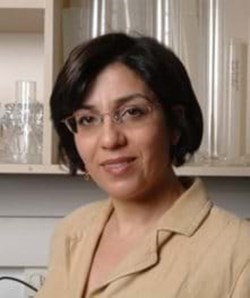
Enzymes—the proteins responsible for chemical reactions in living cells—change their structure at dizzying speeds.This dynamic action makes them very efficient, but it can also make them difficult to study. Prof. Irit Sagi of the Weizmann Institute of Science’s Department of Biological Regulation develops new experimental tools and procedures to study shape-shifting enzymes in real time and at the scale of individual atoms.
For the past ten years, we’ve been especially fascinated by enzyme scalled matrix metallo proteinases, or MMPs, that act like molecular scissors. They chop and dice tissue components like collagen and gelatin,” says Prof. Sagi. “We want to understand the molecular mechanisms that drive the chemical reactions of these enzymes.”
Since MMPs play a role in cancer, inflammatory diseases, and autoimmune disorders, Prof. Sagi and her research team investigate ways to inhibit their activity. Their goal is to design new drugs that could block the action of specific MMPs. Such drugs could potentially be used to treat a wide variety of illnesses, including colon cancer, multiple sclerosis (MS), Crohn’s disease, and rheumatoid arthritis.
Prof. Sagi and her colleagues developed an innovative technique that enables them to precisely track complex changes as they actually take place in an enzyme. The method, which works in a live cell environment,allows the team to identify the movements of single atoms residing within the active site of an enzyme molecule. The scientists freeze the process at various stages, and then apply techniques borrowed from the fields of x-ray spectroscopy and structural chemical analysis to determine the configuration of the molecule at each of those stages.
“We can monitor structural changes in real time,” says Prof. Sagi.“Enzymes are dynamic, and if you don’t take this into account when you design drugs, that’s part of the reason the drugs may fail.”
Prof. Sagi focused on a member of the MMP enzyme family known asMMP-9, which is produced in metastatic cancer cells and in tissues attacked by autoimmune disease. Using the research techniques she pioneered in her lab, Prof. Sagi revealed the entire structure of this enzyme. And after studying MMP-9 in great detail, her team decided to design special inhibitors to thwart its harmful action.
Prof. Sagi notes that, over the years, several pharmaceutical companies have designed drugs that inhibit matrix metallo proteinases.“But they turned out to be non selective inhibitors with a broad range of activity, and they caused serious side effects in patients in clinical trials,” she says. “The challenge is to design drugs that target these enzymes in a highly selective way.”

Another enzyme that has caught her interest is TNF alpha convertase,which is thought to be involved in many diseases, including cancer. TNFalpha convertase cleaves a protein called PRO-TNF alpha, slicing through the part of its structure that attaches it to the inside of the cell wall. The released PRO-TNF is then free to act in the cell. If too much of this protein is released at once, disease can develop.
Prof. Sagi and her team, along with Dr. Marcos Milla of Roche Palo Alto, LLC, observed the changes that occur in TNF alpha convertase as it makes contact with PRO-TNF alpha. Their findings could help researchers develop drugs that target TNF alpha convertase and reduce PRO-TNF activity, and which are more effective and less likely to cause side effects than current drugs.
Born in Israel, Prof. Sagi received her PhD at Georgetown University. Her return to Israel as a postdoctoral fellow at the Weizmann Institute was followed by a stint at the Max Planck Institute in Hamburg, after which she joined the Weizmann staff in 1996. She says that she particularly values the collaborative spirit of her fellow faculty members. “The Weizmann Institute is a rather small place and we all work together, and some of us even live on campus,” she says. “It’s very informal, which contributes to the great atmosphere.”
Prof. Irit Sagi’s research is supported by the Ilse Katz Institute for Material Sciences and Magnetic Resonance Research; the Leona M. and Harry B. Helmsley Charitable Trust; the Spencer Charitable Fund; Cynthia Adelson, Canada; Michael and Rhoda Ambach, Boca Raton, FL;and Dr. Mireille Steinberg, Canada.
Prof. Sagi is the incumbent of the Maurizio Pontecorvo Professorial Chair.
